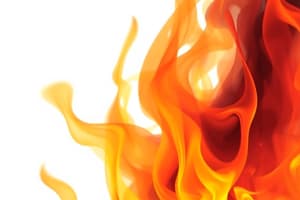Podcast
Questions and Answers
What is combustion?
What is combustion?
- A substance that can start a fire.
- A chemical reaction between a fuel and an oxidizing agent producing energy. (correct)
- The maximum temperature a liquid can reach before igniting.
- A type of fire that involves plastics and rubber.
What defines a flammable liquid?
What defines a flammable liquid?
- Any liquid that evaporates quickly.
- Any liquid with a flash point above 140°F.
- Any liquid that produces high levels of vapor at room temperature.
- Any liquid with a flash point below 140°F. (correct)
What is the flash point of a substance?
What is the flash point of a substance?
- The temperature at which a liquid gives off vapor capable of forming an ignitable mixture. (correct)
- The maximum temperature a liquid can reach without producing vapor.
- The minimum temperature a liquid must reach to ignite.
- The temperature at which a liquid starts to boil.
What does UFL stand for in fire safety terminology?
What does UFL stand for in fire safety terminology?
What type of materials does Class A fire involve?
What type of materials does Class A fire involve?
What is the lower flammability limit (LFL)?
What is the lower flammability limit (LFL)?
Which of the following describes heat of combustion?
Which of the following describes heat of combustion?
What type of fire does a Class K extinguisher primarily address?
What type of fire does a Class K extinguisher primarily address?
What does a numeric rating of 5BC indicate for a Class B or C fire extinguisher?
What does a numeric rating of 5BC indicate for a Class B or C fire extinguisher?
Which of the following is NOT an exception for hydrostatic testing of fire extinguishers?
Which of the following is NOT an exception for hydrostatic testing of fire extinguishers?
For which type of area are dry pipe systems typically installed?
For which type of area are dry pipe systems typically installed?
What equipment does a Class C fire extinguisher target?
What equipment does a Class C fire extinguisher target?
What is indicated by red diagonal lines on the new labeling system for fire extinguishers?
What is indicated by red diagonal lines on the new labeling system for fire extinguishers?
What kind of combustible materials are involved in Class D fires?
What kind of combustible materials are involved in Class D fires?
What does the number rating of a Class A extinguisher signify?
What does the number rating of a Class A extinguisher signify?
Which fire extinguisher is suitable for flammable liquids?
Which fire extinguisher is suitable for flammable liquids?
What is the maximum spacing allowed between sprinkler heads in a light-hazard occupancy area?
What is the maximum spacing allowed between sprinkler heads in a light-hazard occupancy area?
What defines a light-hazard occupancy area?
What defines a light-hazard occupancy area?
What is the maximum spacing between sprinkler heads in extra-hazard occupancy areas?
What is the maximum spacing between sprinkler heads in extra-hazard occupancy areas?
What does flash point refer to?
What does flash point refer to?
What is the relationship between fire point and flash point?
What is the relationship between fire point and flash point?
What does vapor pressure depend on?
What does vapor pressure depend on?
What are components with high vapor pressures commonly referred to as?
What are components with high vapor pressures commonly referred to as?
What is the term for the temperature at which a substance continues to burn after ignition?
What is the term for the temperature at which a substance continues to burn after ignition?
Flammable and explosive limits refer to:
Flammable and explosive limits refer to:
What temperature must ambient conditions reach for dry pipe systems to function?
What temperature must ambient conditions reach for dry pipe systems to function?
What is a key characteristic of deluge systems?
What is a key characteristic of deluge systems?
What distinguishes water spray systems from other systems?
What distinguishes water spray systems from other systems?
How are preaction systems classified?
How are preaction systems classified?
What is a common application for foam water sprinkler systems?
What is a common application for foam water sprinkler systems?
What must happen for water to be released in preaction systems?
What must happen for water to be released in preaction systems?
What feature do water spray systems share with deluge systems?
What feature do water spray systems share with deluge systems?
Where are deluge systems most commonly installed?
Where are deluge systems most commonly installed?
What happens when a sprinkler head in a dry pipe system is opened?
What happens when a sprinkler head in a dry pipe system is opened?
What must be done to reset a deluge system after activation?
What must be done to reset a deluge system after activation?
What does the upper flammable limit (UFL) refer to?
What does the upper flammable limit (UFL) refer to?
What is the autoignition temperature?
What is the autoignition temperature?
How is specific gravity defined?
How is specific gravity defined?
What characterizes gases with a vapor density greater than or equal to one?
What characterizes gases with a vapor density greater than or equal to one?
What does the evaporation rate of a substance indicate?
What does the evaporation rate of a substance indicate?
Flashcards
Combustion
Combustion
A chemical reaction between a fuel and an oxidizing agent that produces energy, typically heat and light.
Heat of Combustion
Heat of Combustion
The amount of heat (in calories) released when 1 gram of a substance burns completely.
Combustible Liquid
Combustible Liquid
A liquid with a flash point between 140°F and 200°F. It can ignite if heated to its flash point.
Flammable Liquid
Flammable Liquid
Signup and view all the flashcards
Flash Point
Flash Point
Signup and view all the flashcards
Upper Flammability Limit (UFL)
Upper Flammability Limit (UFL)
Signup and view all the flashcards
Lower Flammability Limit (LFL)
Lower Flammability Limit (LFL)
Signup and view all the flashcards
Autoignition Temperature
Autoignition Temperature
Signup and view all the flashcards
Specific Gravity
Specific Gravity
Signup and view all the flashcards
Vapor Density
Vapor Density
Signup and view all the flashcards
Water Solubility
Water Solubility
Signup and view all the flashcards
Evaporation Rate
Evaporation Rate
Signup and view all the flashcards
Class C Fire Extinguisher
Class C Fire Extinguisher
Signup and view all the flashcards
Class D Fire Extinguisher
Class D Fire Extinguisher
Signup and view all the flashcards
Class K Fire Extinguisher
Class K Fire Extinguisher
Signup and view all the flashcards
Wet Pipe Sprinkler System
Wet Pipe Sprinkler System
Signup and view all the flashcards
Dry Pipe Sprinkler System
Dry Pipe Sprinkler System
Signup and view all the flashcards
Hydrostatic Test
Hydrostatic Test
Signup and view all the flashcards
Exceptions to Hydrostatic Test
Exceptions to Hydrostatic Test
Signup and view all the flashcards
Fire Extinguisher Number Rating
Fire Extinguisher Number Rating
Signup and view all the flashcards
New Fire Extinguisher Labeling
New Fire Extinguisher Labeling
Signup and view all the flashcards
Dry Pipe Systems
Dry Pipe Systems
Signup and view all the flashcards
Deluge Systems
Deluge Systems
Signup and view all the flashcards
Water Spray Systems
Water Spray Systems
Signup and view all the flashcards
Foam Water Sprinkler Systems
Foam Water Sprinkler Systems
Signup and view all the flashcards
Preaction Systems
Preaction Systems
Signup and view all the flashcards
Wet Pipe Systems
Wet Pipe Systems
Signup and view all the flashcards
Sprinkler Head Activation
Sprinkler Head Activation
Signup and view all the flashcards
Distribution System
Distribution System
Signup and view all the flashcards
Dry Pipe Valve
Dry Pipe Valve
Signup and view all the flashcards
Deluge Valve
Deluge Valve
Signup and view all the flashcards
Sprinkler Spacing in Light-Hazard Areas
Sprinkler Spacing in Light-Hazard Areas
Signup and view all the flashcards
Sprinkler Spacing in Ordinary-Hazard Areas
Sprinkler Spacing in Ordinary-Hazard Areas
Signup and view all the flashcards
Sprinkler Spacing in Extra-Hazard Areas
Sprinkler Spacing in Extra-Hazard Areas
Signup and view all the flashcards
Vapor Pressure
Vapor Pressure
Signup and view all the flashcards
Fire Point
Fire Point
Signup and view all the flashcards
Flammable and Explosive Limit Ranges
Flammable and Explosive Limit Ranges
Signup and view all the flashcards
Lower Flammable Limit (LFL)
Lower Flammable Limit (LFL)
Signup and view all the flashcards
Upper Flammable Limit (UFL)
Upper Flammable Limit (UFL)
Signup and view all the flashcards
Study Notes
Domain 5: Fire Protection and Prevention
- Domain 5 encompasses 10.59% of the curriculum.
Definitions
- Combustion: A chemical reaction between a fuel and an oxidizing agent, producing heat and light.
- Heat of combustion: The amount of heat released when 1 gram of a substance is burned.
- Combustible liquid: Any liquid with a flash point of 140°F or higher and below 200°F.
- Flammable liquid: Any liquid with a flash point below 140°F and a vapor pressure not exceeding 40 psia at 100°F.
- Flash point: The minimum temperature at which a liquid emits enough vapor to form an ignitable mixture with air.
- Upper flammability limit (UFL): The maximum concentration of a combustible substance that can support a flame.
- Lower flammability limit (LFL): The minimum concentration of a combustible substance that can support a flame.
Classification of Fires
- Class A: Fires involving common combustibles like wood, paper, cloth, and rubber.
- Class B: Fires involving flammable liquids, gases, and solvents.
- Class C: Fires involving energized electrical equipment.
- Class D: Fires involving combustible metals like magnesium and sodium.
- Class K: Fires involving combustible cooking oils and grease.
Portable Fire Extinguishers and Travel Distances
- Extinguishers are rated for different classes of fire (e.g., Class A, B, C, etc.).
- Travel distances to extinguishers vary based on the hazard level.
- Maximum coverage areas for different fire extinguishers are specified.
Automatic Sprinkler Systems
- Dry Pipe Systems: Installed in areas prone to freezing, water is not present until triggered.
- Wet Pipe Systems: More common, water is constantly present in the pipes.
- Water Spray Systems: Protect uniquely configured hazards.
- Deluge Systems: Used in areas with rapid fire spread.
- Preaction Systems: A hybrid of wet, dry, and deluge systems, activated by a fire detection system.
- Foam Water Sprinkler Systems: Used for flammable liquids and large fires.
Sprinkler Head Color Codes
- Sprinkler heads have color codes indicating maximum ceiling temperatures.
NFPA Standards and Classifications
- NFPA (National Fire Protection Association) standards define allowable spacing between sprinklers.
- Fire hydrant colors indicate flow rate.
- Flammable liquids are classified by flash point and boiling point.
- Combustible liquids are also categorized by flash point and boiling point.
Additional Fire Safety Concepts
- Fire point: The temperature at which a substance continuously gives off flammable vapor, higher than the flash point.
- Flammable and Explosive Limits: Ranges of concentrations where a mixture is flammable or explosive.
- Autoignition Temperature: The lowest temperature at which a material ignites without a spark or flame.
- Specific Gravity: Describes the density of a liquid compared to water.
- Vapor Density: Describes the density of a gas or vapor compared to air.
- Evaporation Rate: Rate at which a liquid evaporates.
Storage Requirements for Flammable and Combustible Liquids
- OSHA regulations define maximum allowable sizes of containers for both flammable and combustible liquids.
- Container types (e.g., glass, metal drums, etc.) are specified for each class.
Studying That Suits You
Use AI to generate personalized quizzes and flashcards to suit your learning preferences.




